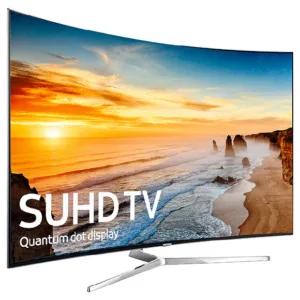Samsung has not officially revealed any details about it TV plans for 2017, which they will unveil at CES. But a news story in the ET Times of Korea and some info from other sources suggests the company’s new TVs will offer some impressive gains. So impressive, I suspect their performance will be one of the hot topics of discussion at CES.
The first clue came at IFA 2016 where the Samsung booth was all about quantum dots. It would not be surprising if Samsung is “all in” on quantum dots at CES in 2017.
According to the ET Times article, Samsung has also filed for several new trademarks at the US patent office. This includes the names “HDR1500”, “Q HDR” and “Real Black”. The publication speculates that since Samsung already has the trademark “HDR1000”, that the new trademarks suggests at least one Samsung TV will offer a peak luminance of 1500 nits for 2017. That’s not surprising as the peak luminance of 2016 top performers was in the 1200 nit range.
The ET Times article also quoted a Samsung source revealing that next year’s HDR TVs “will have a greatly improved color volume value.” Since 2016 SUHD TVs could reach just under the DCI-P3 Color gamut, it would not be a stretch to assume that the company will achieve 100% of DCI-P3 color gamut compliance with some or all of the is QD-based TVs.
But you may also see a strong move by Samsung to focus on the color volume characteristic from a marketing point of view. As many readers know, focusing on the 2D CIE color gamut chart is an antiquated way to characterize the color performance of an HDR TV. With such a wide range of luminance values available in HDR content and HDR TVs, the color performance can vary greatly based on the luminance of a pixel. Color volume is a better way to characterize performance and will give Samsung an improved vehicle to show off the capabilities of its HDR TVs compared to OLED HDR TVs.
The “Real Black” trademark is interesting too as it suggests there may be improvements in the black level of the Samsung HDR TVs. This is certainly one area where OLEDs have an advantage – deep black levels. But in reality, that deep black level advantage is greatly reduced once you add some ambient illumination to the room. And many consumers watch TV with some lights on.
In a dark room, however, OLED’s black levels do shine. If Samsung can get its black levels lower by an order of magnitude – and reduce the haloing that is apparent on direct backlight LCD architectures, then they can truly compete with OLED in any environment.
My sources suggest that indeed this may be the case. And, there may be another nugget or two of technology innovation to be revealed at CES. I’ll leave you with this: it looks like Samsung has addressed every shortcoming their HDR TVs had in 2016 with innovations for 2017. I can’t wait to see them at CES 2017. – CC
Samsung contributed to the editorial cost of creating this content which was independently written and edited

